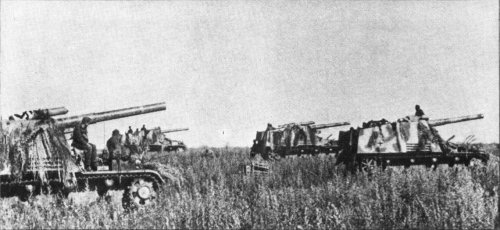Panzerhaubitze III/IV Hummel

|
The Panzerhaubitze III/IV Hummel (Armored Howitzer III/IV
"Bumble Bee") was the last of the self-propelled artilleries. Previous
models like the
Bison and
Wespe had small chassis that limited the weight and firepower of
their guns and as a result were becoming obsolete in the escalating
gun-and-armor race. In order for the Hummel to mount a heavy field
howitzer a special chassis blending features from both the
PzKpfw III and
IV was built (also used by the
Nashorn tank-destroyer). The Hummel first saw action at Kursk in
1943 and eventually fought on all fronts. In the beginning six Hummel
plus two
Munitionsfahrzeuge III/IV (ammunition carrier) made up the mobile
heavy battery of a Panzer or Panzergrenadier division; later some
divisions were allotted two batteries. Overall the Hummel fulfilled its
mission of providing mobile artillery support for the mechanized units
and was liked by the crewmen, who practically lived in their Hummel as
they moved with the fluid frontline. In all 666 Hummel and 157
Munitionsfahrzeuge III/IV were produced. The Hummel was built with a top-open compartment housing the gun crew and mounting the field howitzer on the hybrid chassis. First developed in 1941, the special chassis stretched the suspension, running gear and hull of the PzKpfw IV and fitted them with the final drive assemblies, track and transmission of the PzKpfw III. The superstructure was very lightly armored, just enough to protect the crew from small-arm fire and strafing, but since the Hummel was not expected to engage enemy armor this usually posed no problem. Armament consisted of a sFH 18 L/30 heavy field howitzer, with a range of 13,325m, and a machine gun for close defense. The superstructure was roomy enough for its crew to operate the field piece but could accommodate only 18 rounds of the 43.5kg shells, making it necessary for the Munitionsfahrzeuge III/IV to run frequent re-supply rounds. Each Hummel had a crew of six or seven. Only the driver and radio operator sat in the fully enclosed hull, so it was common for the crew to weatherproof the open compartment with canvas tarpaulins. Some models were equipped with the Ostkette wide tracks for maneuver over Russian mud and snow. One disadvantage was that the vehicle posed a high silhouette. |








